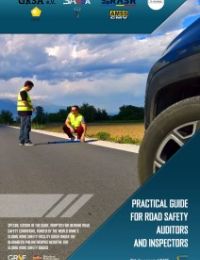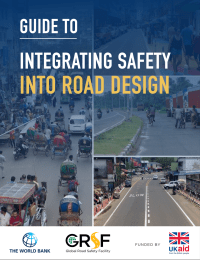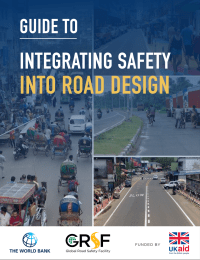Publications
1-4 of 4
-
-
-
-
Road Infrastructure
Practical Guide for Road Safety Auditors and Inspectors in Ukraine (Ukrainian)
July 2022

Walking is a predominant mode of travel in Addis Ababa representing more than half of the daily trips. The mild climate in Addis Ababa is conducive for this healthy and green mode of transport. However, sidewalks are often narrow, uneven, obstructed, or non-existent, causing discomfort and road safety risks to the most vulnerable road users: pedestrians. Studies done by the WHO and the Government showed that AA has disproportionately high pedestrian fatalities.
The study on Addis Ababa Sidewalk Safety and Improvement takes the approach of integrating digital technology and Urban Inventory in sidewalk surveys, applies the Global Walkability Index in sidewalk assessments, and adapts the global best practice to the local context. The Addis Ababa Sidewalk Design and Maintenance Guidelines seek to promote the development of quality pedestrian infrastructure and environments, based on the condition’s assessment and global best practices. The design specifications and visual rendering provide recommendations for the policy makers to consider when developing the City’s design and maintenance standards for urban roads, sidewalks, public spaces, and transit-oriented development, some of which are being carried out as part of the technical assistance program of the World-Bank financed Transport Systems Improvement Project (TRANSIP).

After almost two decades of experience with Road Safety Audit (RSA) Worldwide, this procedure is now recognized as one of the most efficient engineering tools. RSA is a highly efficient and cost-effective engineering tool for improvement of safety on roads. It is much cheaper to identify road safety deficiencies in the process of design than later after construction is completed. RSAs are among the most cost-effective investments a Road Authority can undertake.
With its EU Directive No. 2008/96 and amendment 2019/1936 on road infrastructure safety management, the European Union (EU) made a clear decision that RSA will be mandatory for the Trans-European Road Network (TERN) and main roads. This Directive contains another tool called Road Safety Inspection (RSI) on safety deficiencies of existing roads. The RSI is very similar to the process of Road Safety Audit in the pre-opening phase of newly constructed roads. RSIs are essential for the redesign and upgrading of existing roads, and these are done in many countries to give the designers insights and direction for safety improvements. Given that, the purpose of this practical guide is to provide practical guidance to those doing RSAs and RSIs, the examples of typical design deficiencies shown should be useful to both road safety inspectors and road safety auditors.
This document draws on the more comprehensive guidelines and manuals on Safety engineering mentioned in the acknowledgements but deliberately focuses only on these issues of direct relevance to road safety auditors/inspectors and to the road safety reports that they must prepare, including of recommendations for improvements.
This is a special edition of the guide, adapted for Ukraine road safety conditions and legislation, funded by the World Bank‘s Global Road Safety Facility (GRSF) under the Bloomberg Philanthropies Initiative for Global Road Safety (BIGRS).

This guide focuses on elements of safe road and roadside designs for road networks that can provide safe mobility to all road users
A substantial reduction in road deaths will only be feasible if concerted efforts are made, following the “Safe System” approach involving all elements of road safety, management, and delivery. This includes all pillars of the Safe System—starting from road safety management, safe roads and roadsides, safe speed, safe vehicles, safe road users, and post-crash care. This guide focuses on elements of safe road and roadside designs for road networks that can provide safe mobility to all road users, as well as complementary changes to improve speeds, vehicle safety, road user behaviors, and post-crash care. A balanced road design must take into account these complementary system elements to maximize safety benefits. The energy carried by a moving object is proportional to the square of its speed. A well-designed “forgiving roadside” ensures that this energy is dispersed in a crash, and as a result, less energy is transferred to the occupants.
Road infrastructure design plays a vital role in road safety outcomes. Safe infrastructure supports other road safety pillars by encouraging appropriate road user behavior (such as appropriate speed and correct lane position) and by providing a forgiving road environment if things go wrong. Poorly designed road infrastructure can give rise to dangerous road user behavior. One of the key realizations of the Safe System approach is that drivers make mistakes and will continue to do so, even if we can reduce how often these occur. This road user error has long been recognized as a significant contributor to poor road safety outcomes. However, roads of any given speed can be designed to reduce the likelihood of crashes occurring, and there is very clear evidence that the severity of outcomes when crashes do occur is significantly influenced by the road design. Even if a crash still occurs, improved road infrastructure can save many lives and prevent debilitating injuries.
The Safe System approach highlights that a shared response is required to address road safety. This means that road users will continue to take responsibility for their actions, for instance by being alert and compliant with road rules. However, it is also recognized that road managers and designers have a significant responsibility to provide a road system that protects all road users. This can be achieved through appropriate designs of roads.

Після майже двох десятиліть досвіду проведення аудиту безпеки дорожнього руху (RSA) у всьому світі ця процедура визнана одним із найефективніших інженерних інструментів. RSA є високоефективним і економічно вигідним інженерним інструментом для підвищення безпеки на дорогах. Набагато дешевше виявити недоліки безпеки дорожнього руху в процесі проектування, ніж пізніше після завершення будівництва. RSA є одними з найбільш рентабельних інвестицій, які може здійснити дорожнє управління.
У своїй Директиві ЄС № 2008/96 і поправці 2019/1936 щодо управління безпекою дорожньої інфраструктури Європейський Союз (ЄС) прийняв чітке рішення про те, що RSA буде обов’язковим для Транс’європейської мережі доріг (TERN) і магістральних доріг. Ця Директива містить інший інструмент під назвою «Інспекція безпеки дорожнього руху» (RSI) щодо недоліків безпеки існуючих доріг. RSI дуже схожий на процес аудиту безпеки дорожнього руху на етапі перед відкриттям новозбудованих доріг. RSI мають важливе значення для редизайну та модернізації існуючих доріг, і вони проводяться в багатьох країнах, щоб дати проектувальникам зрозуміти та вказати напрямки для покращення безпеки. Враховуючи те, що метою цього практичного посібника є надання практичних вказівок тим, хто проводить RSA та RSI, наведені приклади типових недоліків конструкції мають бути корисними як інспекторам безпеки дорожнього руху, так і аудиторам безпеки дорожнього руху.
Цей документ спирається на більш вичерпні рекомендації та посібники з техніки безпеки, згадані у подяках, але навмисно зосереджується лише на тих питаннях, які мають безпосереднє відношення до аудиторів/інспекторів з безпеки дорожнього руху та до звітів з безпеки дорожнього руху, які вони повинні підготувати, включаючи рекомендації щодо покращення.
Це спеціальне видання посібника, адаптованого до умов безпеки дорожнього руху та законодавства в Україні, фінансованого Глобальним фондом безпеки дорожнього руху (GRSF) Світового банку в рамках Ініціативи Bloomberg Philanthropies for Global Road Safety (BIGRS).




